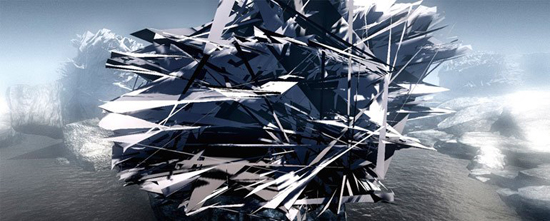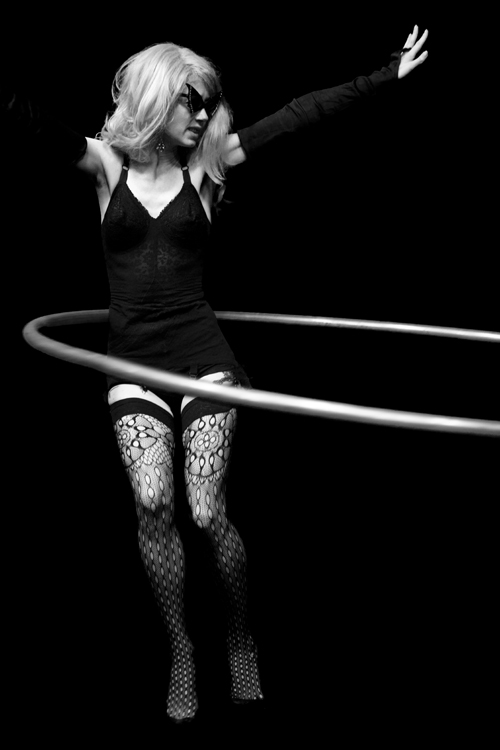No remote required as Andrew Frost visits a trio of new media exhibitions…
The consensus on the fourth outing for the bi-annual Anne Landa Award is that it’s probably the best since the first exhibition back in 2004.
David Haines and Joyce Hinterding, The outlands, 2011, production still. Courtesy of the artists and BREENSPACE, Sydney
The 2011 selection came courtesy of New Zealand curator and author Justin Paton and drew in pretty decent selection of work, from Charlie Sofo‘s delightful installation of paint slivers and crash zooms on suburban cats [all of whom seem to be saying “who me?!!”], to Ian Burns elaborate sculptural set ups that serve as stage settings for mini-movies [Superman, Miami Vice et al] to Arlo Mountford‘s animated painting to Rachel Khedoori‘s creepy pan through a forest reflected in a mirror [which in turn creates the sensation of a 3D image]. Jae Hoon Lee‘s computer-created wall works that greet the visitor to the show seems like a sly joke – video art has become wall paper, so why not actual wall paper? It fits the new media bill nicely, and it looked good.
The winners of the 2011 ALA, David Haines and Joyce Hinterding, won for their interactive piece The Outlands, an uncanny recreation of the Blue Mountains and what appeared to be a sci-fi disco ballroom that one had to navigate to find a way out into the various “environments”. The work had all those Haines/Hinterding trademarks – sublime technological encounters mediated through what appears to be a straightforward staging that, thanks to our familiarity with gaming technology, allowed most visitors easy access to their virtual world. And of course the soundtrack was brilliant too. With our collective memory of the duo’s past works, this award has been widely acknowledged as just and right and very, very good. It also augers well for the ALA in the future [fingers crossed].
One of the issues that has followed in the wake of video art/new media’s heightened profile over the last decade has been how to construct a meaningful curatorial engagement with it. Awards like the ALA are in many respects an old fashioned way of dealing with new media. Prizes raise profiles, create discussion and hopefully some modicum of critical engagement, and that’s all good stuff. But the problem with art prizes generally is that they tend to constrict attention spans to the role call of who won what and for which work, and then on to the next prize. Where the ALA lost its focus in previous years, 2011 feels a lot stronger for the fact that the selection covers a number of generational lines, has a decent variety of work, and looks to Australians working overseas for a mixture of approaches. Gone are the gargantuan and absurdly overblown installation pieces and instead we have manageable works that look like they come from an artist’s studio and not the showroom of Aero Furniture.
The alternative to prizes is for galleries to support and exhibit new media works as a regular part of their exhibition roster. Happily, the Art Gallery of NSW has been doing that of late and coinciding with the ALA is Sam Smith‘s Cameraman at the Contemporary Project Space. A friend who went to see Cameraman told me that they stayed all the way through the 30 minute piece because, shock horror, they wanted to find out what happens in the end! Smith’s work has, over the last couple of years, delved further and further into the relationship between the language of cinema, new media and how the meeting of the technologies old and new that create a hybrid experience of reality. Recent works such as Permutation Set [2010], Time Travel [2009] and Into The Void [2009] have dispensed the complications of earlier installations in favour of trimmed down but no less fascinating screen works. Cameraman is a two screen work – and that’s it – no sculptures or portals or doorways, but the narrative relationships between the two screens left and right of the viewer are as elegant and intriguing as we’ve come to expect from Smith. There is a story of sorts involving doppelgangers, magic, levitation and moody shots of Berlin. There is also a stunningly beautiful soundtrack. Some question whether there is a meaningful relationship between cinema and video art but Smith’s work demonstrates that, in the right hands at least, there is a future.
Alex Davies Black Box Sessions [2011] at UTS Gallery is a fantastically creepy experience. You enter a dark room alone. Once inside, and you feel your way to a peep hole, a private show unfolds inside. Only you’re in there as well. You can see yourself looking into the peep hole and there, right behind you, a performer emerges from the darkness… Are they really there? A repeat trip back into the room reveals another performer – it might be an exotic dancer, a magician or a rambling speech from a self-styled philosopher. In the waiting room outside the black box the visitor can see a surveillance camera that captures part of the backstage area where the performers are readying themselves. Make up mirrors, coffee and tea, a guy tuning a guitar. You can hear them talking just on the other side of a wall. Davies’ work is incredibly elaborate but offers no immediate explanation of itself. It revels in its own ambiguity, perceptual and conceptual, and the viewer has to untangle its implications. As Davies himself might say, it’s a real pickle.
Anne Landa Award, 2011
Art Gallery of NSW, until July 10
Sam Smith – Cameraman
Art Gallery of NSW, until August 14
Alex Davies – The Black Box Sessions
UTS Gallery, until 15 July
Viewing this post via email and can’t see the video? Click here to view.


